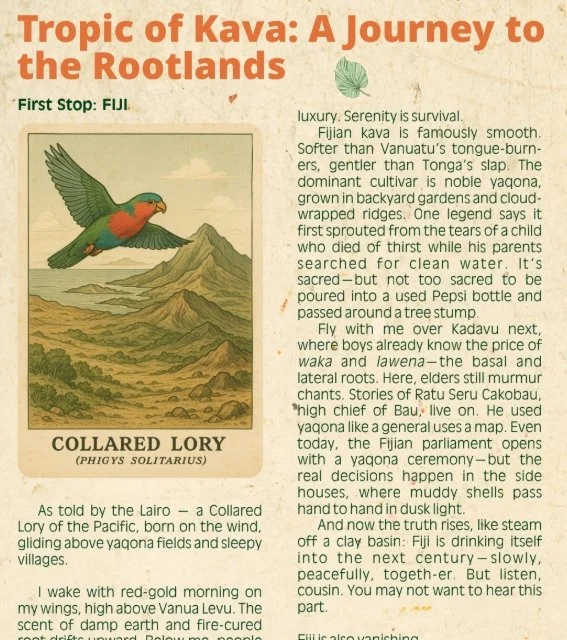Back to the Rootlands: Fiji
Tropic of Kava: A Journey to the Rootlands
First Stop: FIJI
Each month, AKT features articles about each of the islands of origin that comprise the kaleidoscope of kava. In the coming months, we’ll fly to Tonga, Vanuatu, the Solomon Islands and, of course, Hawaii.
As told by the Lairo — a Collared Lory of the Pacific, born on the wind, gliding above yaqona fields and sleepy villages.
I wake with red-gold morning on my wings, high above Vanua Levu. The scent of damp earth and fire-cured root drifts upward. Below me, people move slowly—like the kava they’ll soon stir into cloudy water, thick as lowland mist.
In this first dispatch of Islands in the Shell, we begin where the water speaks softest and the root runs deepest: Fiji. Not a dot on your travel map, but a place where kava is not a drink—it’s a bloodstream. I should know. I’ve watched it swirl in coconut shells long before anyone gave it a Latin name.
Forget the postcard. Yes, you’ll see chiefs in sulu at ceremonies, voices echoing in bure huts. But the real kava life? It’s constant. It’s casual. It’s quiet and lived-in. Plastic bowls at dawn. Muddy shells under starlight. Root-water in recycled bottles. If you’re a janitor, a farmer, a postman—or just someone with a long morning and no rush to anger—you’ve got a buzz by noon. Maybe a sugarcane stalk in your teeth, too.
This isn’t shameful. It’s strategy. In a nation of 333 islands—some vanishing into the sea—conflict is a luxury. Serenity is survival.
Fijian kava is famously smooth. Softer than Vanuatu’s tongue-burners, gentler than Tonga’s slap. The dominant cultivar is noble yaqona, grown in backyard gardens and cloud-wrapped ridges. One legend says it first sprouted from the tears of a child who died of thirst while his parents searched for clean water. It’s sacred—but not too sacred to be poured into a used Pepsi bottle and passed around a tree stump.
Fly with me over Kadavu next, where boys already know the price of waka and lawena—the basal and lateral roots. Here, elders still murmur chants. Stories of Ratu Seru Cakobau, high chief of Bau, live on. He used yaqona like a general uses a map. Even today, the Fijian parliament opens with a yaqona ceremony—but the real decisions happen in the side houses, where muddy shells pass hand to hand in dusk light.
And now the truth rises, like steam off a clay basin:
Fiji is drinking itself into the next century—slowly, peacefully, together.
But listen, cousin. You may not want to hear this part.
Fiji is vanishing.
Not metaphorically. Inch by inch. Cyclone by cyclone. Saltwater is climbing into cassava fields. Since 2014, six villages have been swallowed by the sea. With them go dialects, songs, memory-maps.
And maybe—just maybe—the roots knew.
Maybe kava’s global rise is not coincidence, but calling. A planetary plant with a final message. A liquefied wisdom. A peacekeeper offered just before the tide.
Drink deep, distant cousin.
Your island is shrinking, too.


